Here’s how to avoid buying an expensive doorstop.
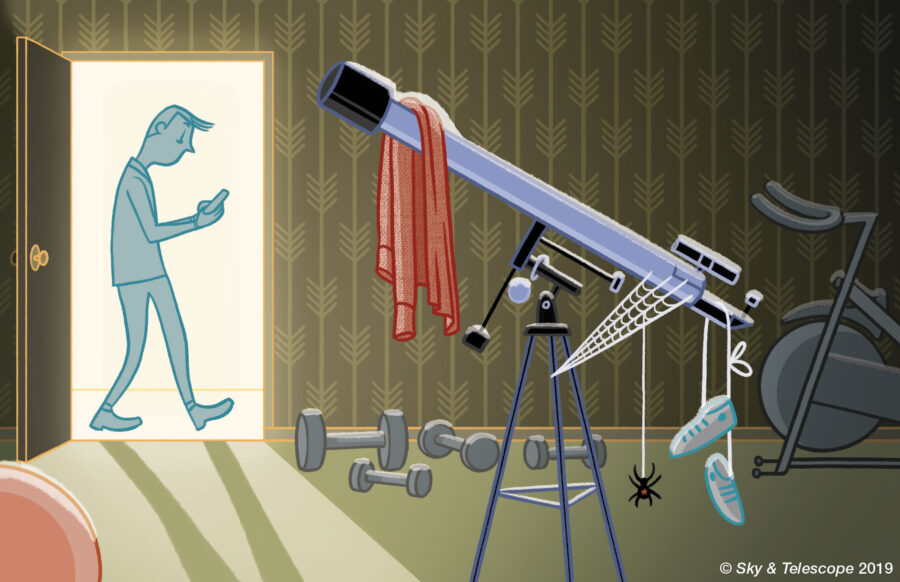
Leah Tiscione / S&T
Every January my astronomy club hosts a telescope workshop in which we help people learn how to use the telescopes they got for the holidays or tune up scopes that have been gathering dust in closets. And every year we face the same problem: how to gently tell some of them that what they’ve got is better suited for a boat anchor than for astronomy.
It may be hard to believe, but some telescopes are worse than having no scope at all. When you want to enjoy a night out under the stars, you’re better off with a pair of binoculars or just with your naked eyes than with a telescope that can’t be aimed easily and doesn’t show a pleasing view of whatever you do manage to point it at. I’ve watched people spend all night trying to find something, anything, to look at, often spending their entire time fiddling with the scope rather than observing the sky. It only takes a couple of nights like that for a person to decide that astronomy isn’t any fun — thus the term “hobby killer.”
As with so many other things in life, education can help you avoid making frustrating mistakes. If you’re a beginner, a few minutes reading this article before you buy a telescope can save you a lot of disappointment later. Making an informed choice can get you a scope that will provide you with many years of enjoyment.
So what makes a hobby killer? Many factors add together to make a lousy overall package. Chief among them are aperture, eyepieces, and the mount.
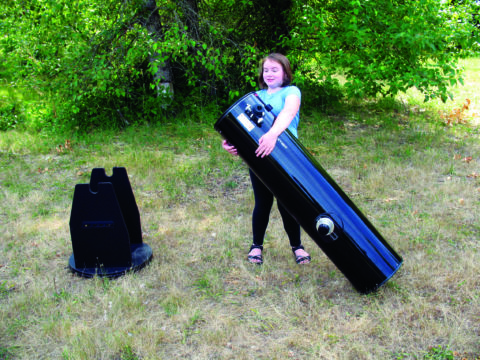
Jerry Oltion
Aperture
A telescope’s primary job is to gather light and squeeze that light down into a small beam that it directs into your eye. It stands to reason that the more light you gather, the more you can see. So in general, the bigger the aperture (the diameter of the objective lens or primary mirror) the more useful the scope. That’s true up to a point, but if you buy a scope that’s too big and unwieldy, it could become a hobby killer simply because it’s too difficult to take outside and set up. What you want is the right-size scope for your interest level and ability.
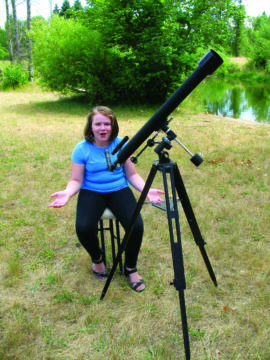
Jerry Oltion
Anything below about 3 inches (76 mm) in aperture is likely to be too small to provide a pleasing view of anything more than the Moon and a few bright star clusters. Small scopes tend to be low-quality, too, with uncorrected objective lenses that display color fringing around bright objects and often won’t even come to sharp focus. So as a general rule, stay above three inches in aperture. There are, of course, some very high-end small scopes, mostly optimized for astrophotography. The price tag will tell you which is which.
Most small hobby killers tend to be refractors (with an objective lens in front) rather than reflectors (with a mirror at the bottom). Mirrors are easier to make than lenses, so within any particular price range reflectors tend to be larger. So a typical low-end reflector will be 4″ or so in diameter. A very common size is 4.5″, and 4.5″ is plenty of aperture for a first scope. You can see hundreds of objects with a good 4.5″ scope.
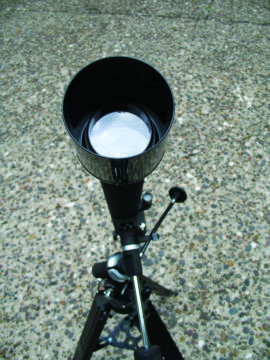
The key word is “good.” There are rotten reflectors as well as rotten refractors. What makes a reflector good? Most important: is the primary mirror parabolic or spherical? A spherical primary is cheaper to make but provides a less pleasing view. You can get away with a spherical mirror if the focal ratio is “slow” enough, say f/8 or more (i.e., the focal length of the scope is 8 times the diameter of the mirror), but even then a parabolic mirror will work better. If a manufacturer of a low-end telescope goes to the trouble to parabolize the primary mirror, then odds are it’s a reasonably good telescope.
There’s one design you should avoid at all costs: the “Bird-Jones” reflector. The Bird-Jones design uses a spherical primary, and a fast one at that, in an attempt to keep the tube shorter than average. Manufacturers of this design correct for spherical aberration and increase the focal length by placing a corrector lens at the inner end of the focuser. The corrector lens is supposed to make everything all right again, but it never does. The view through every Bird-Jones scope I’ve ever looked through has been uniformly awful. There might be a decent Bird-Jones telescope somewhere out there, but if there is, I’ve never seen nor even heard of it.
Eyepieces
In the early days of telescopes, eyepieces were single pieces of glass that essentially acted as magnifying lenses that let you examine the image created at the focal plane by the objective lens or primary mirror. Modern eyepieces do the same job, but they use many more lens elements to correct for color fringing and other optical aberrations.
Different designs of eyepiece give you different fields of view. Some, such as the Orthoscopic design, are like looking through a soda straw, while other exotic wide-field designs are like sticking your head into the bubble-shaped observing port on the International Space Station.
Guess which kind you get with a hobby killer? Most of them come with “Huygens” eyepieces, which were state of the art when Christiaan Huygens invented them . . . in the 1660s. We’ve advanced a bit since then. You want at least Kellners, or better yet, Plössls. Plössl eyepieces are probably the best value you can get in an inexpensive eyepiece.
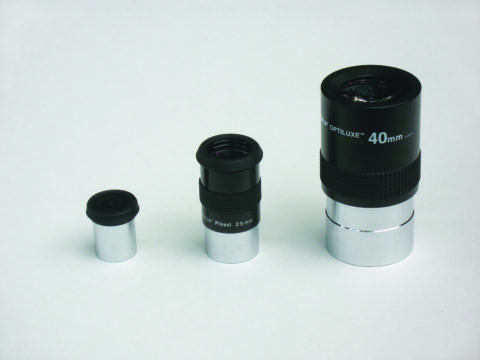
Also beware of teeny-weeny eyepieces. Good eyepieces are either 1.25″ or 2″ format, meaning their barrels are meant to fit into 1.25″ or 2″ focusers. A lot of hobby killers use 0.965″ eyepieces, which are almost always garbage and are hard to replace with better-quality designs due to this size limitation.
Magnification
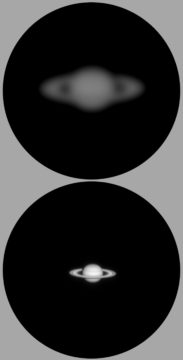
You’ll want more than one eyepiece, because eyepieces are how you control the magnification of your telescope. You calculate magnification by dividing the eyepiece focal length into the telescope’s focal length. For instance, a 900-mm telescope with a 25-mm eyepiece gives you 36× — (900/25 = 36).
You might think you want the highest magnification possible, but that’s not so. The higher the power, the smaller the field of view, which means you’ll only see a part of M45, the Pleiades star cluster, or M31, the Andromeda Galaxy. Also, the higher the power, the fuzzier the view. A good telescope lets you reach about 50× per inch of aperture before the fuzziness gets out of hand, so a 3″ scope would let you use 150×, but beyond that you’re just magnifying the blur, a phenomenon known as empty magnification. That means a 3″ by 900-mm telescope can use a 6-mm eyepiece, at best — (900/6 = 150).
So there’s a clue when you go shopping. Does the ad on the website or on the box tout the telescope’s magnification? If it’s a 3″ aperture and they’re advertising that it will do “675×!!!” they’re blowing smoke. Move on.
Most hobby killers will come with a 4-mm eyepiece, which is nearly useless on its own, but it will also come with a Barlow lens, which increases the magnification of whatever eyepiece you put into it. Most Barlows multiply by 2×, so your 4-mm eyepiece plus Barlow on that 900-mm scope gives you a whopping 450×, or (900/4) ×2. Remembering our 50× per inch rule, you would need a 9″ diameter telescope to use 450× effectively.
What you want for your telescope is a good low-power eyepiece, probably a 32-mm or 25-mm Plössl, and a medium-power eyepiece, around a 10-mm Plössl. You can increase your collection as you gain experience.
The Mount
This is the real killer. A great scope with the best eyepieces in the world can still become a hobby killer when it’s put on a lousy mount.
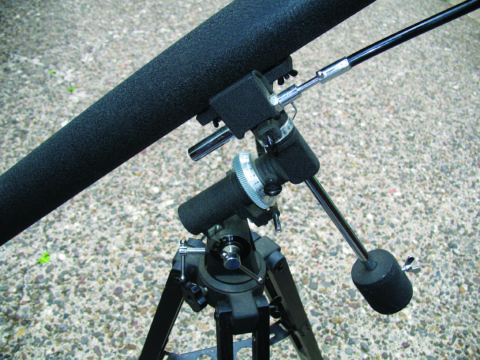
I’ll make an absolute statement here: An equatorial mount is a poor mount for a beginner. Later on, when your hobby has flourished, say you concentrate on planetary observing or have taken up astrophotography, you might happily consider paying tens of thousands of dollars for the best equatorial mount on the planet. But to start out with, equatorial mounts are simply awful. They’re difficult to set up, difficult to use, and the cheap ones are shakier than a leaf in a breeze.
Equatorial mounts are not just difficult to use, they’re difficult to even comprehend at first. Simply trying to figure out how to orient the thing has killed the enthusiasm of many would-be astronomers.
So don’t get an equatorially mounted telescope until you’ve been in the hobby awhile. Or never: Most observers don’t require an equatorial tracking mount.
Altitude-Azimuth (alt-az) mounts are the way to go. For refractors, that means a solid mount on a steady tripod that lets you tilt the scope up and down and swivel it left and right. The scope should move smoothly, and it should stop when you stop pushing without bouncing back and without wiggling. If you tap the end of the telescope tube and it takes more than 3 or 4 seconds to settle down, you don’t want that mount.
For reflectors, the Dobsonian mount is the way to go (with one exception: the Orion StarBlast mentioned below). It’s basically a cannon mount, and it works like a dream. It’s stable, smooth, and intuitive. When John Dobson introduced this mount to the astronomical world back in the 1970s, he made this hobby truly accessible for the first time. See my column (S&T: December 2019, p. 72) on how to use Dobson's design to breathe new life into a poorly mounted hobby killer.
Computerized Mounts
More and more lately you’ll find hobby killers that have been computerized. The computer itself doesn’t necessarily make it a hobby killer, although it can if the mount is a piece of junk, which most of the truly low-end ones are. It’s just that putting a lousy little scope on a computerized mount doesn’t make the scope perform any better.
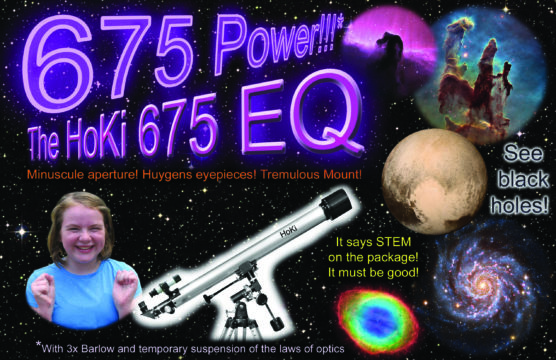
“No knowledge necessary!” the ads will say. Aside from the fact that most of us get into astronomy to learn stuff, that’s seldom true anyway. With a low-end Go To scope (which is what the computerized ones are called), you’re likely to learn quite a bit of computer debugging and maybe even mechanical repair skills before you even get your first look through one. Seriously, I have seen people spend their entire night fiddling with the electronics, trying in vain to get the computer to work properly, and never once getting to look at anything in the sky.
On the other hand, a good computerized mount can be an amazing experience. Several manufacturers now build systems that recognize the star field when you power them on and reliably know where to go when you tell them what you want to look at. It’s just that these good systems cost a fair amount of money, and you’re unlikely to get a good one at a beginner’s-scope price.
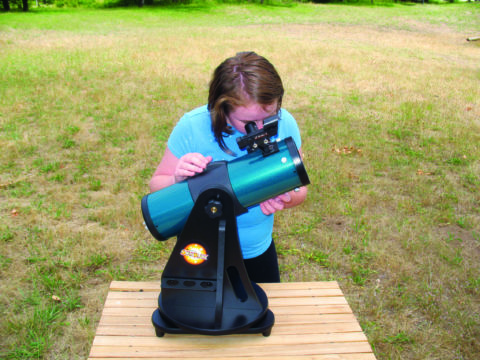
Recommendations
There are too many awful scopes out there to name them all. But I can happily name some good ones. Over the years, I’ve narrowed it down to three I can endorse without reservation:
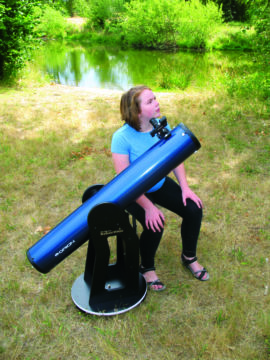
Since you get more bang for your buck with mirrors, I recommend that your first scope be a reflector. The Orion 4.5 StarBlast Astro Reflector Telescope is a good place to start. It’s easy to carry, easy to set up, and easy to use. The Astronomical League and many individual astronomy clubs give these to libraries to loan out to patrons, and the scopes provide great views and survive a lot of use.
If you have a little more money and don’t mind a bigger package, go for a 6″ or 8″ Dobsonian. I like the SkyQuest or SkyLine lines, also from Orion, but other manufacturers make good Dobs, too — Meade’s LightBridge series telescopes are worth checking out. I recommend a 6″ as a good grab-and-go scope that you won’t outgrow right away. If you’ve got enough muscle to carry something a bit larger, get the 8″ and it’ll last you a lifetime. With the Dobs, get a 10-mm Plössl eyepiece to go with the 25-mm that often comes with it.
There are undoubtedly other good beginners’ scopes out there. But there’s a lot of dreck, too. Pay attention, and try to avoid buying something you’ll never use. If you want to get into astronomy, make sure you get a hobby starter, not a hobby killer.
Contributing Editor Jerry Oltion started with a hobby killer, but his astronomy club helped nurse his interest back to health. This article first appeared in print in the December 2019 issue of Sky & Telescope.
 32
32
Comments
paul-livio
November 26, 2019 at 1:50 pm
Jerry:
Thanks for your informative article! Over the years frustrated beginners have brought me telescopes to repair. Your excellent advice will help parents choosing Christmas gifts. I noticed you left out the emoji for "bad" telescopes that was included in the December issue. I always thought the crossed eyes emoji meant "drunk astronomer".
Paul
You must be logged in to post a comment.
Gary85
November 26, 2019 at 3:19 pm
I couldn't disagree more as somebody who got an equatorial mount (eq5) as a first telescope mount! It is not very difficult at all as long as you are willing to learn. As for cheap ones being wobbly; so are cheap alt az mounts.
You must be logged in to post a comment.
dblighwv
November 29, 2019 at 4:37 pm
I couldn't possibly agree with you more, Gary. I used my Newtonian for astrophotography. I can't imagine how to guide an alt-azimuth for extended exposures. Perhaps computer control could compensate. After all, the big boys do it; but at what cost?
You must be logged in to post a comment.
Neville
November 30, 2019 at 5:50 am
I like most of this article but disagree COMPLETELY about equatorial mounts. I couldn't believe what I was reading. Never mind astrophotography - rough and ready polar alignment is all you need to keep an object in the field of view - simply tweak the RA knob to follow the object Easy! This is ideal for letting newbies have a look - all you need to show them is how to turn the RA knob for a nice long relaxed look without having to hear them say - "Its gone". Buy a rubbish equatorial mount - that's your problem. Buy a rubbish Alt-Az - same thing. Generally low-end Alt-Az's are worse rubbish than most low-end Alt-Az's. I always advise newbies to start with an equatorial.
You must be logged in to post a comment.
LouIII
January 1, 2021 at 10:59 am
My first telescope was a 70mm f/10 on an equatorial mount. Although the concept of polar aligning it was clear, in practice turning knob caused a bit of shake in the scope. I quickly got the impression that equatorial mounts are, at best, a mixed blessing until you get into something really big (heavy) and stable.
For a grab-and-go scope, it was a little awkward to carry up and down my apartment stairs. If I was going outside for a quick observing session, it was easier to lock the scope sideways and use it as an alt-az mount.
I'm not saying that equatorial mounts are a bad choice for everybody. I think they're a great choice depending on what you want to do. For me, an alt-az mount works better.
You must be logged in to post a comment.
William-Moser
December 2, 2019 at 10:14 am
I also agree totally with you. In addition to the other comments, have you ever shown inexperienced observers a view through your telescope and had them gaze for minutes after you knew the object had drifted out of the field of view? Eventually, they say "Maybe I'm not seeing it any more." If you're using an alt-azimuth and the object is anything but the moon, you'll spend several minutes trying to find it again. With an even roughly polar aligned equatorial, moving the scope on one axis will return the object to the field; maybe not in the center, but at least you can continue without a delay. As well, if you get an equatorial and really want an alt-azimuth, just set it for the north pole. Presto! Your equatorial has become an alt-az.
You must be logged in to post a comment.
plawler
December 1, 2020 at 5:41 am
Several minutes? I use an alt-azimuth mount and finding the object again takes less than a second.
You must be logged in to post a comment.
Pencil BFB
November 28, 2019 at 10:04 pm
We Filipinos barely sell binoculars or telescopes
You must be logged in to post a comment.
sl0j0n
November 29, 2019 at 10:42 pm
Hello, Mr. Oltion;
Thank you for this.
I'm sad to write it but in general, truer words were not written.
I'd mentioned to my wife that I'd like to have a telescope so she bought me a Tasco "Spacestation" 70 mm f/11.4 refractor.
Actually the objective is pretty decent but of course the rest is merely expensive junk.
I mounted it on a cheap EQ mount [doesn't even have the elevation set screw seen in your photo] w/ a decent wooden tripod--it'll do until I can afford to 'step up' to a homemade pipe mount on a modified surveying tripod, my 'dream' mount.
But my 2nd 'scope ain't too bad--an Orion StarBlast 6" w/ the 'push-to' option. I need to build a portable tripod base for it [see ].
Thanks again, & have a GREAT day, Neighbor!
Clear skys!
j
You must be logged in to post a comment.
Dobsonite
November 30, 2019 at 2:17 am
Nice to see articles like this regularly. So many get a trashy 60mm refractor with an equally trashy equatorial mount, and get turned off the whole hobby before they begin.
I'm sorry to say there's no way to instant gratification. The best way to go is to:
1. learn the night shy. Sit down on a good night with a modest sky atlas or constellation finder and a pair of binoculars.
2. When you feel comfortable with that, go for a small Dobsonian such as the Astroblast. (I only wish they could have put a Crayford focuser, but...)
3. How's your back? Don't "overgun" yourself. I know a lot of people with 14, 18 and 22" monsters who only get them out once a year.
4. Age and strength counts for something. "The best telescope is the one you use most often." True, with the exception of anything like what the author has laid out. I built my own 8" F/6 Dob 23 years ago, and the old bones are feeling that 30-lbs per section lift and carry; (plus chairs, eyepiece case, etc... it's in better shape than I am! ...hey, _I_ might wind up with a Starblast myself! (With a few mods....)
You must be logged in to post a comment.
Dobsonite
November 30, 2019 at 2:19 am
Sorry...That should have been "...the night SKY." Jeez, the old peepers are giving out too! 🙂
Wish this comment section had an "edit" button".
You must be logged in to post a comment.
GerryB2020
December 4, 2019 at 11:09 pm
This! People have always asked me that classic question, we all know it; "Whats the best telescope?" I cannot count how many times I have given this exact response! Right-on Dobsonite.
You must be logged in to post a comment.
richard szweda
November 30, 2019 at 11:31 am
Raw beginners, especially one in the age range of the gal in the photos, live in an instant "point and shoot" world. The more fuss and bother getting that telescope pointed and getting an eye to that eyepiece, regardless of optics quality, the more that beginner's interest will evaporate. And I'm measuring that "fuss and bother" time in seconds to 3 or 4 minutes. If there is an equatorial mount out there that can be aligned and a target seen at least in the spotter scope in that time frame by that raw beginner --- great ! Otherwise, it seems to me, some other mount would be the way to go.
You must be logged in to post a comment.
Night Owl
November 30, 2019 at 3:42 pm
Thanks for the article! I have an Apertura 8 in Dobsonian reflector. I enjoy using the telescope. It brings in good details and an enjoyable viewing experience. However I do have a smaller 4.5 in Star Blast reflector I use when I just want to grab and go. My AD8 scope is nice, but it is heavy. I purchased a four wheeled cart to transport the scope around. I also use 12 x 70 mm binoculars to observe the heavens with on a tripod. I also use 6 x 30 mm binoculars for scanning the sky. Works well for a wide view of the sky.
I learned how to use an equatorial mount on an earleir telescope without any problems. Do your research before you purchase a telsecope and mount. Clear Skies!
You must be logged in to post a comment.
GH Martin
November 30, 2019 at 9:22 pm
Having taught Jr. Hi science for 27 years and being a member of our local astronomical society for most of that time, I fielded many questions from parents about what telescope they should get their kid for Christmas, birthday, or whatever. My advice -- get TWO telescopes! Actually, a pair of binoculars, which are really two telescopes hinged together in the middle. At the time I was teaching, the best value in a pair of binoculars suitable for astronomy would be a pair of 7x35s, which would also be a good size (weight wise) for a 12 to 14 yr.old to handle. That, and a decent, easy-to-use but comprehensive star atlas along with a constellation finder star wheel.
My thinking was that for a kid to get interested in astronomy, he or she needs first to be able to find their way around the sky. The star atlas will show the beginner where to look to find clusters, nebulae, the Andromeda galaxy, etc., and the binocs will whet their interest enough to learn more and want to see them in more detail. THEN is when they'll be ready for a telescope. At any rate, he or she will still need the binoculars when they have a telescope, so the binocs are the perfect "starter". Of course, if they have the advantage of living where there is a good astronomy club or society with telescopes for the members to use, they won't have to buy a scope at all!
You must be logged in to post a comment.
marty0750
December 1, 2019 at 6:16 am
I agree with the "equatorial" posters. Now, I am aware this topic is about buying rather than building telescopes but I have a home made 8-inch f/8 with a smooth turn-on-thread pipe mount Newtonian. It only takes a few moments to show a newbie how to simply hand-push the tube naturally in one axis to follow the the diurnal motion of a target with ease. They intuitively take to it without further ado! In one instance I had to go off for a bit to do something and on returning I found they had on their own acquired the Moon without any further instruction and were happily tracking it in diurnal motion as before!
As for the Dobson alt-az mount in order to track an object successfully one is continuously making tedious step-wise adjustments that require a nudge on BOTH axes A caveat of the Dobsonian is the zenith dead spot. Alt-az tracking through or near zenith, where the objects are viewed at their best has one twisting and contorting the scope with frustration not only to find the object but to track it. I usually recommend users to tip the mount with a wedge under the base about 10 so degrees (not more for obvious reasons). This nudges the telescope axis away from the zenith improving acquisition and tracking.
The point about 0.96" eyepieces. Again, a good Kellner works very well. Sure, smaller field of view but just as sharp in the centre view as any of the Plossls I own. In fact my livery of eyepieces for my 8-inch ARE 0.96's Kellners and Orthoscopics. One is in fact a cannibalized binocular 20mm eyepiece that has a remarkable FoV 65-deg! and performs sharply to about 80% of the Field. Perhaps we need a manufacturer that can design a beginner scope with a sturdy equatorial mount.
Yes people-children get into astronomy to learn, and learning about how telescopes work is about as important as, for example those who wish to take up photography need to know how cameras work. Point and shoot photography is as point and shoot astronomy . It is entry by consumerism. As GH Martin posted above, not only do they need to know how to find their way around the sky they need to know too about how their telescope works.
Marty
You must be logged in to post a comment.
marty0750
December 1, 2019 at 6:25 am
Good heavens. A typo!. My home made is a 6-inch f8 (not 8-inch).
Marty
You must be logged in to post a comment.
33333_others
December 1, 2019 at 4:40 pm
Wow. It's so funny and also sad because many years ago I got a telescope with all the no no's you mention here. It was a Christmas gift from my siblings, I was kind of into astronomy when I was younger and I remember eyeing telescopes whenever I walked by a store, so I guess they noticed an wanted to do something nice, but honestly it was hell to use the telescope, I had to put it together every time I wanted to use it because I didn't have room to just leave it laying around somewhere and I could only see the moon because everything else looked too blurry and the equatorial mound wouldn't let me see stuff that wasn't on the sky, like mountains or, uhm, girls passing by (I was a teenager when I got it), even to this day my siblings still ask me where it is and I lie to them and tell them I used it a few weeks ago when in reality it's been in the attic for like 15 years now.
You must be logged in to post a comment.
lRaziel1
December 2, 2019 at 9:08 pm
Great article, but sounds a bit pessimistic IMO so i'm putting my grain here.
Dobs are the way to go yes, but they are also much less common in the low end, that makes both avaliability and pricing, problems. Some people simply don't have the money to afford what most would call a decent telescope, "Save more money" is not really helping either.
In my country, i couldn't find any Dob, used or new that didn't cost four times my budget. Only high end dobs are sold here. In fact, recently there was this big star gazing and astronomy event around my city's unviersity, and out of 200+ telescopes, i only spotted 2 Dobsonians.
That said, you make it sound like anything below 200 USD is just garbage, which is argueable, but for the most part that's enough for a starter, then you recommend binoculars, In my city's case i completely disagree. Binoculars are next to usdeless here because of light pollution, you really do not see more than with the naked eye, here even a 50mm telescope as toyish as it is, will give you better views; and quality binoculars come to prices close to a good 70mm refractor so i wouldn't recommend them in my specific context.
That said, EQ1 mounts which are usually mounted on flimsy aluminum tripods are not really good not only because they are actually not really good, but because they cost more than their AZ mount counterparts. On the other hand, EQ2 mounts are surprisingly better than what they were 10-15 years ago and usually come mounted in steel pipe tripods which are both sturdier and better built. Not ideal but much better.
I also noticed you make a comparisson, while factual, really unfair and rather tricky, with your Saturn's image. You show what a 70mm at 400x shows, and what it looks on a better telescope. and a better eye piece. I mean, what si that supposed to mean lol? If i pay mroe i see more?
The thing is that a 70mm should never be used with anything that pushes magnification more than 150x (perhaps 170x) cause it will look like that. Overpowering a telescope no matter the price, will result in images like that, but you make it seem like it only looks bad because its a 70mm refractor.
In my 70mm refractor and a decent 9mm eye piece with a 2x barlow, i can see saturn with as much detail as the 2nd picture, now of course it looks considerably smaller in your FOV, but detail is crisp and present.
Now to my final point, AZ mounts and small scopes. For prices like $100-200 there are many 70mm refractors and short focal lenght 100mm reflectors, which would give a sort of similar image.
Usually mounted on low end tripods.
Are these good? Probably not if you are biased towards using high end equipment. Are they usable for a starter to learn the sky? Hell yes.
Some people are put down when they read these sort of things, how awful those tripods are and such, but a starter does not have the bias of how much better high end equipment is, thus cannot say in his mind "this is so bad and unusable", a newbie just goes and use it and tries to make the best out of it.
Conclusion, astronomy is an expensive hobby. But that doesn't mean you should wait 4 years to save your salary to buy something decent. In the meantime, get a 70mm or 80mm refractor on an AZ mount and use whatever tripod it has. Buy it from a brand with a name or expect low quality lenses and eyepieces. At this price viewfinders are crappy so get one with a red spot one and the one that has the better eyepieces. I'd recommend Celestron AstroMaster and Meade Infinity ones.
Reflectors usually are a little more tricky to use (optimal temps, collimation, weight, size, etc-) but if you prefer it get one with an aperture bigger than 100mm, or expect to see less than with a 70mm refractor.
You won't compete with the Hubble Telescope, but you'll have a blast staring at the stars, the moon, some planets, even the the birgthest nebula and clusters which are completely invisible in heavy light polluted cities, maybe comets if you get lucky... i've seen an equal amount of people where the "hobby killer" is either a cheap toy telescope, and not having money. Believing $50 scopes will do for a kid or teen only to frustrate him out of astronomy, or believeing that only $300+ scopes are worth it because while that may be spare change for some, thats half of someone's montly salary.
Don't be discouraged and get an AZ mounted quality 70mm refractor, cheap and will allow you to know the sky and see quite somethings while you save for something better.
Happy observing everyone!
You must be logged in to post a comment.
plawler
December 1, 2020 at 5:47 am
Yes. If you pay more, you see more. 😉
You must be logged in to post a comment.
AB
December 4, 2019 at 11:10 pm
I agree about the EQ mount... my first telescope was a "toy" from a yard sale (that still cost $80) on an alt/az mount and I could barely find ANYTHING in the sky with it. And then, when you did, "it's gone". After reading articles like this some years ago, I did my homework and got a decent little 70mm EQ refractor, and am mostly happy with it. For a casual look at something from the back porch, I do a quick-&-dirty polar alignment over my roof and then enjoy being able to track things easily with just a little turn of the knob. An accessory I highly recommend is a red-dot finder. I was still having a bit of trouble finding things but no more... once it's aligned, that red-dot finder is da bomb.
You must be logged in to post a comment.
astrowestie
November 28, 2020 at 9:08 am
This article fails to recognize what an impediment to the joy of astronomy that the occasional need to collimate a reflector telescope can be for someone new to the hobby. If you have a particular newtonian that holds collimation well, great. Not everyone is going to be so lucky, even if they buy the same brand your telescope that holds collimation has. For this reason, I would almost exclusively recommend 80-100mm achromatic refractors with the understanding that the color correction will not be perfect. However it is a great starting point for learning. Collimation can lead to confusion and disdain for the hobby with the uninitiated. I have seen in happen many times.
You must be logged in to post a comment.
BlueTrane2028
December 1, 2020 at 2:11 pm
As a child, I was gifted a 60mm f/15 refractor on a GEM.
It didn't collect a lot of photons. Part of it was the eyepieces being pretty much junk, part of it was the finder being pretty much junk and the bulk of it was the instructions for the GEM being far too complicated. As an adult, I know that for visual purposes it's "set angle to latitude, point RA axis as north as you can get it but if it's not perfect you'll still be fine, have fun." As a child, it was a several page operation, and I was too impatient to look.
As an adult, I started out with an 8" Dob. Didn't consult any site, just saw it on Craigslist and said "yes, that looks awesome." It truly was, although I did sell that one along the way. Interest re-kindled. Further down the line, I tried my hand with the equatorial mounted refractor again, and I was pleasantly surprised... AFTER I swapped in a conversion diagonal to let me use a set of Plossls (I use high end wide angle eyepieces normally, but for the old refractor the full set of Plossls I've amassed is very appropriate). I also swapped the finder for a basic red dot. Next, I'm going to remount the scope in a set of rings instead of being bolted directly on the mount, so I can rotate it as needed to more comfortably use the finder throughout the entire range of motion.
The bulk of that frustration would've been avoided by just getting an Alt-Az mount from the start.
I guess, in closing, it's not necessarily the aperture that kills things for a beginner, it's the complexity. I buy and sell nearly constantly, helps me to get some excellent gear and I nearly always make money at it. I've sold some scopes with equatorial mounts since to new users, I made sure to go over how the mount works before taking money. So far, everyone seems happy.
Once the COVID situation has passed, I fully intend to bring a few different scopes to star parties going forward. 60mm f/15 eq refractor will factor in for sure, so people know what they can actually do and not do. "Want to buy your first scope? Take a walk with me...."
You must be logged in to post a comment.
emagowan
December 15, 2020 at 11:47 am
No mention of used gear. I think used is where folks can get the most bang for their buck, provided they have the advice or assistance of someone experienced. The best place for that advice is a local astronomy club... which can also be a good source for quality used gear. Those who get bitten by the bug will be upgrading and will often let used gear go for a fraction of the new price. ALL of my scopes and mounts have been bought used, I could never have accumulated the assortment had I bought new.
You must be logged in to post a comment.
Shoaib Akram
December 17, 2020 at 1:27 pm
I am a school teacher from Pakistan, where astronomy is still very novel and telescopes are extremely expensive. I've been saving money for some years now to buy my first telescope for my students who are so interested in space. This article literally saved me from committing a grave mistake, and saved my 3 year savings. In a year or two I'll have enough money to buy my first tele and I'll absolutely make sure to pass my gratitude to you infront of all my students. Thank you so much. Much love ❤️
You must be logged in to post a comment.
LouIII
January 1, 2021 at 11:05 am
One caveat about tabletop reflectors like the Starblast is that you need someplace stable to put them while observing. You could get a stool, but at that point it might be easier to go with a 6-inch Dob that can be carried as one unit. Another interesting choice is the 4.5-inch Orion SkyQuest.
I think Celestron's Inspire line, particularly the 102mm f/6.7 refractor, is an interesting grab-and-go option. I don't know how stable the mount is, but I like that it's easily collapsible for transport and storage.
You must be logged in to post a comment.
Brian-Karas
September 27, 2021 at 9:09 pm
For the most part I thought this was an excellent article that gave good advice. I disagree about the EQ mounts though. My first telescope was a 6” f/8 Newtonian with an EQ mount and I thought it was very easy to use. Even if the polar alignment was only approximate it tracked pretty accurately. I’ve been observing now for over 50 years, and even worked as a professional astronomer, and EQ mounts are all I’ve ever used. When my brother came to me for advice on a first scope I steered him to an EQ mounted 6”, and he loved it. But aside from that I though the advice on what and what not to buy was very good. Start modestly and see how it goes. If you really like what you see and want more you’ll eventually move up. I have three scopes now, a 6” f/12 refractor and two Newtonians, a 6” f/8 and a 10” f/5, and they all get plenty of use.
You must be logged in to post a comment.
wishingwell
October 24, 2021 at 6:16 am
When I was 16 mum bought me a 60mm refractor with 0.965 eyepieces. The 6mm was never good and I eventually stopped using it altogether but the 20mm opened up the heavens to me!
It was alt/az with an excellent slow motion azimuth control but a nearly useless altitude thumbscrew control - oh how I wished I had an equatorial mount, even a cheap one! But I stuck with it and it has rewarded me countless times.
Like a lot of people I’ll never forget my first view of Saturn, Jewel Box, Wishing Well, Trapezium and other wonders. Yes it was a lot of work to find them but I got to learn large sections of the night sky at the same time.
If astronomy is a burning passion for you then you will find a way to make use of what you have, but if it’s not then maybe the best telescope in the world will be seldom used.
You must be logged in to post a comment.
Alain Maury
November 20, 2021 at 8:34 pm
I would agree on most points of the article. A few comments nevertheless.
In my younger time, one would be able to find good quality eyepieces in 24.5mm (japanese standard). I still have an OR12mm which showed me the bands on Jupiter for the first time (which I had not been able to see with the H20 or H6mm that came with my 3" reflector). They are not made anymore. I have a young niece who somehow inherited the same type of reflector, but the eyepiece were Huyghens type, but with plastic lenses. And the 6mm was in reality something like a 15 (not much difference in magnification with the 20mm). I looked all over the internet to find a good OR type eyepiece for her, and couldn't find one. So we bought here a new 1.25" focuser and some decent eyepieces.
Indeed one should really avoid the short 4.5" reflectors. I once got to see such a scope, no correcting lens, but which gave nevertheless not that horrific images, and not much coma. There had to be a trick. If the mirror had been an F/4 parabola, it would have cost a lot more, and show coma near the edges.I understoof the trick, the secondary was very small (same size as for an F/9 scope) and in reality one was using like the center 2.5" of the mirror. You purchase a 4.5" telescope and get a 2.5"... I realized this, putting my eye in the focuser, no eyepiece, and putting my hand in front of the telescope, moving it toward the center till I could see it.
As far as the EQ/AZ mount, the point is that the equatorial you showed, and most very low cost equatorial mounts are so flimsy that indeed, while they can't be used as an anchor (or a very lightweight one) they can be used as an anemometer and seismograph, entering in vibration at any opportunity. But if you purchase a 4.5" reflector on at least an EQ3 style mount or bigger, you can be perfeclty happy.
In the end, I believe it's really the passion of the observer which will make the difference. I had a very lousy scope, and used it like crazy, saw many faint galaxies, etc... Some people today purchase a very expensive, very automatic 3000$ type telescope, and sell it used after 2 nights and a half.
You must be logged in to post a comment.
Alan MacRobert
November 22, 2021 at 11:10 am
Alain, Thank you for pointing out that some cheap telescopes have smaller-than-advertised apertures because they are stopped down internally -- whether to deliberately mask bad optics, like you pointed out -- or I suspect just careless, uninformed design by a designer who didn't know what they were doing and didn't bother to draw up a ray-traced blueprint to see what they were actually making.
You must be logged in to post a comment.
Alan MacRobert
November 22, 2021 at 11:04 am
Thank you so much for this article! Just two points:
1) You missed the likelihood of mediocre to bad optics. Years ago we ran a test for Sky & Telescope at Stellafane, with four identical 6-inch reflectors aimed at Polaris, a nice unequal double star that doesn't move. Their mirrors were carefully figured and measured, by an optical expert with professional gear, to be 1/2-wave, 1/4-wave, 1/8-wave, and 1/20 wave (all paraboloids of course). We carefully collimated them.
Without identifying which was which, we spent much of the night getting just over 100 people to look through the telescopes at high power and rank them. These people included not just serious Stellafaners but spouses, children, and newbie visitors, some of whom had barely looked through a telescope before.
We told them to do the star test (compare the image just inside focus and just outside focus to see if they're the same), and also the "snap test": do the stars snap into tiny, bright sharpness at one exact focus point as you turn the knob, or do they shmoosh through focus a little more slowly and messily? And, to just look for the cleanest, sharpest stars.
We checked the seeing often, and it was very good most of the night.
The 1/2-wave scope was so obviously inferior to everyone, expert or beginner, that we eventually put it aside to save time. The big finding was that during times of fine seeing, *nearly everyone* -- experienced or not -- was able to see that the image shown by the 1/8-wave mirror was less good than with the 1/20-wave mirror.
Conclusion: Even the difference between supposedly "excellent" and "superb" optics is, during fine seeing, visible to anyone -- even beginners -- who looks through the scope really carefully. And who doesn't want to look through their scope carefully?
Manufacturing of large optics being what it is, 1/8-wave is usually given as the standard to require. We found that if you really care about image quality, 1/8-wave is only good enough until you try a better scope under fine seeing; after that you won't be satisfied with "good enough" again. But, good luck finding genuine, smooth, 1/20-wave optics anywhere.
And I've seen cheap telescopes, and some not cheap, that are a lot worse than even 1/2 wave. Years ago I bought a used 12.5-inch f/6 reflector made by a major manufacturer; it had obvious spherical aberration, and when I had the primary mirror professionally tested, it came out as a smooth, 7/8-wave hyperboloid: well made to the wrong spec.
2) I disagree somewhat about an equatorial mount -- if it is STURDY! The motions show where celestial east-west and north-south are in both your finder view and eyepiece view -- making it much easier to compare directions in the eyepiece with a map, or with articles that say "Look 2 degrees northeast of [this] to find [that]." And of course following things takes only 1 motion, not 2.
When I was starting as a teen I had a 6-inch reflector on a heavy old Edmund EQ mount, and its motions definitely helped me find my way. Accurate polar alignment not required; just plunk it down with the polar axis aimed more or less at Polaris.
Alan MacRobert
You must be logged in to post a comment.
gene williams
August 10, 2022 at 5:57 pm
While much of your article is true, I disagree on: 1) equatorial mount as a first scope, and 2) 60mm refractor being "only good for the moon and small open clusters". These two statements are simply not true. I have a 14 inch dobsonian that is used at the dark sky site, and it only gets used about once or twice a month. But when I want instant ultra-sharp, clear images of the moon, Jupiter, Saturn, I break out my Jason 313 that was produced in the 1970s. This little GEM of a scope has been in my arsenal for decades, and has OUTSTANDING optics, a simple-yet-stable equatorial mount, a unique and innovative reflex finder, and even with its 0.965 eyepiece barrel, it only takes "thinking outside of the box" to install a 10 dollar adapter for modern eyepieces. It even accepts a 9mm Nagler. I can lift the entire unit without disassembly with one arm, take it down the stairs, and plunk the thing on the ground and be observing in 1 minute. Just by pointing north and "BAM!". I even leave the eyepiece in the focuser, it is that simple. I would invite you to take a look through my little "junk" refractor before making the over-reaching statement condemning it to the trash heap. I would put the optics of this little gem up against Takahashi any day of the year, and at f/15, it acts as a true APOCHROMAT. The images are the sharpest I have ever seen of the planets HANDS DOWN, albeit the images are small.
You must be logged in to post a comment.
You must be logged in to post a comment.